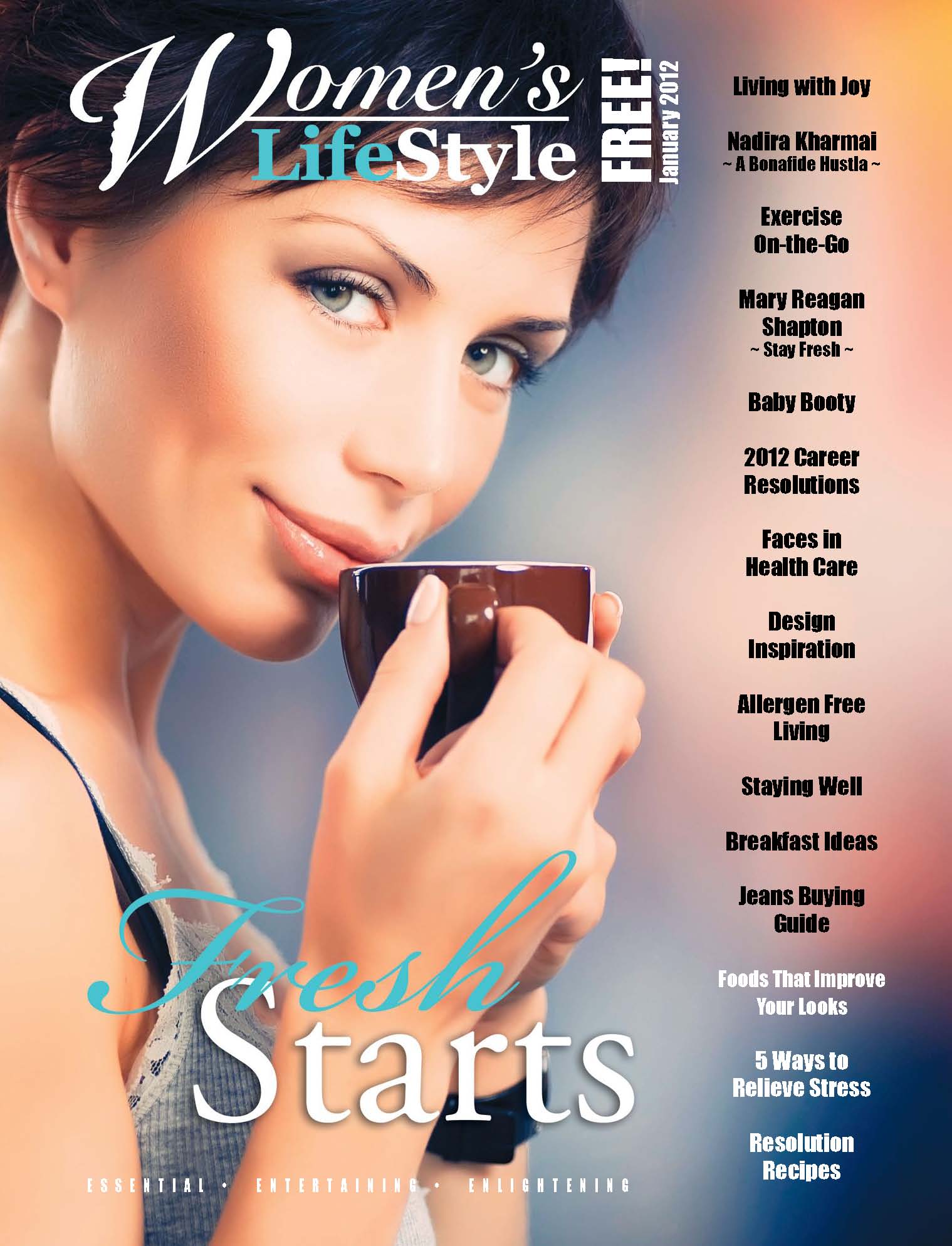10 Steps to Living Allergen-Free (& Doing it Well) - Women's Lifestyle
 Thursday, January 5, 2012 at 2:22PM
Thursday, January 5, 2012 at 2:22PM  Elisabeth Veltman, The Tender Foodie tagged
Elisabeth Veltman, The Tender Foodie tagged  10 steps,
10 steps,  Center for Celiac Research,
Center for Celiac Research,  FAAN,
FAAN,  University of Maryland,
University of Maryland,  food allergies,
food allergies,  food allergy support,
food allergy support,  get started,
get started,  what is a food allergy?
what is a food allergy?  Email Article
Email Article  Print Article in
Print Article in  Doctor Visits,
Doctor Visits,  Food Allergy Facts,
Food Allergy Facts,  Health,
Health,  Tools
Tools  Women's LifeStyle Magazine Jan. 2012 - Fresh Starts (Find this article pgs 36-37)
Women's LifeStyle Magazine Jan. 2012 - Fresh Starts (Find this article pgs 36-37)
After being featured in their October 2011 issue, This Tender Foodie is so pleased to be a new writer for Women's Lifestyle Magazine this year. This article is reprinted here with their permission. But do visit the full January 2012 issue called"Fresh Starts". It is full of great stuff for the new year. Plus, this article (and all of the others) is so gorgeous laid out in the magazine!
Food Allergies Have Risen - Have You Noticed?
The number of people diagnosed with food allergies or intolerances (aka “Tender Foodies”) has risen significantly and rapidly. An online search will lead you to gads of stories about people, including celebrities, who struggle with their reactions to food. To help us understand how quickly food allergies have “spread”; here are a few facts:
• Peanut allergies have tripled from 1997-2008 (FAAN)
• There are 4 times more people with Celiac Disease than there were 50 years ago (March 2011, University of Maryland study).
• 12 million people (and counting) have classic food allergies (FAAN)
• In March 2011, a study revealed that as many as 18 million people are suspected to have gluten sensitivity. (U of Maryland study).
This rapid rise in food allergies has also spawned virtual Petri dish of confusion. Thus, in honor of 2012, this Tender Foodie column will start at the very beginning (it’s a very good place to start) with some tips to help you better understand what your Tender Foodie life is all about.
Take These 10 Steps
1. Understand Your Reaction to Food
There are eight types of foods that cause 90% of all allergic reactions (namely, eggs, dairy, gluten, soy, fish, shellfish, tree nuts, peanuts). Very simply, allergic reactions occur because your immune system mistakes a food (or foods) for a foreign invader. There are several different types of immune responses that can cause a variety of symptoms including hives, itching, eczema, difficulty breathing, swollen joints, diarrhea, constipation, fatigue, nasal congestion, depression, anxiety, anaphylaxis (a severe reaction to an allergen) and possibly death.
So when it comes to living with food allergies, the first step to “doing it well” is to understand your particular reaction to food. Is it a Food Allergy? Intolerance? Sensitivity? Celiac Disease? Or is it something else? This is sometimes difficult to determine, since not everyone defines “food allergy” the same way and not all food reactions are alike. To help, I contacted Sheila George, M.D., C.A. (a family medical practitioner in New York, specializing in chronic disease) and Alessio Fasano, M.D., Director of the University of Maryland Center for Celiac Research. With the input of experts like these, we have compiled a working list of fundamental definitions at www.TenderPalate.com. If we can speak the same language, doctors, patients, friends and families can come to a better understanding and Tender Foodies can live in better health.
2. Find the Right Doctor
If you think your symptoms are because of the food you are eating, it is very important to find the right doctor …and the right diagnosis. There are many types of tests available now, including skin prick tests, blood tests, food challenges, and intestinal biopsies (if warranted, to diagnose Celiac disease). Ask your doctor about the tests available and if you should be referred to a specialist. If you need a guide, bring this article and print out the food allergy definitions page on www.TenderPalate.com.
3. Develop an Emergency Action Plan
You could have more than one food allergy or intolerance, each with a different type of bodily response. Work with your doctor(s) to answer these fundamental questions:
• Exactly which kind of food allergy or reaction do I have?
• Is there an underlying reason for my food allergies or intolerances?
• How do I treat the underlying cause?
• How severe is each allergy/intolerance?
• Which foods (if any) should be on a rotation diet?
• Which foods (if any) must I completely avoid eating?
• Which foods (if any) are dangerous to inhale?
• Do I need an Epi-pen?
• When and how do I use the Epi-pen or any other medication?
Then develop your action plan and review it with your doctor(s). Your plan should include how to recognize each type of reaction, what to do if the reaction is a severe one, and who to include in your plan should action be needed.
4. Learn to Read Labels
It’s not as easy as it sounds. Along with words that even rocket scientists can’t pronounce, labels contain allergens “hidden” from plain view. For instance, most regular soy sauce contains wheat. “Smoke flavoring” can contain barley malt (gluten). Whey is derived from dairy. Livetin contains eggs. “Non-Dairy” does NOT mean “Dairy-free”. Don’t ignore the “May Contain” labeling, either. Significant amounts of an allergen can be present in foods because of processing, even if that allergen is not listed in the ingredients. For more on this, visit “Hidden Allergens” at www.tenderpalate.com. A good general label-reading rule is that if you don’t know what it is, don’t eat it.
5. Do a Pantry Cleanse
If you have a severe reaction to food particles that can become airborne, like wheat flour or peanuts, remove that allergen from your home. Go through your pantry, refrigerator and freezer, and then dump (or give to a food pantry) any food with ingredients you or your family can’t eat. Even your medicine cabinet needs a good “once-over”. Vitamins and medications can be made with or derived from things like wheat, eggs, dairy, corn or yeast. For mixed households with less severe reactions, separate the non-allergenic brands from others to keep from making a mistake or cross contaminating. After all, breadcrumbs can easily make it into the family butter, nut butters can get into the jam (via a knife), wheat crumbs can get on your gluten-free toast (just from the toaster) and sponges can carry allergens from counter to dish . . . (you get the picture).
6. Check Beauty Products
Researchers recently warned that cosmetics like lipsticks, foundations and powders often contain gluten, but are not labeled as such. Vitamin E, for instance, is typically derived from wheat. This can be very dangerous to celiac folks and people with wheat allergies. Check your shampoo. Many skin care products also contain coconut and nut oils, which can cause a reaction in people with those allergies. So don’t stop with the kitchen.
7. Find Your Brands
Adding more whole foods like fruits, vegetables, and whole grains to your diet can help remove those long, multi-syllabic mystery ingredients from your worries. But not all foods are processed alike. Find those brands (whole grains and otherwise) that pay attention to processing and that test for your particular allergies. Some really wonderful brands have popped up, find them and relax a little.
8. Get Out of the Box (and Enjoy it.)
So you can’t eat certain foods. This doesn’t mean that you are banned from the world of culinary delights. Your delights will simply be different. According to many doctors, a varied diet is important to a healthy digestive system. Wonderful grains like quinoa, buckwheat, teff and millet are packed with nutrients. Dairy-free coconut milk and yogurt are filled with those important medium chain fatty acids that are tough to get in other foods. Not all allergen-free products are healthy (some are quite unhealthy), so use your newfound knowledge to be creative, expand your palate and improve your health.
9. Create Your Tribe
It can be tough to “train” your family and friends. It’s hard enough to train yourself. Share this and other articles like it, with anyone who is responsible for feeding a food allergic person. Share the action plan that you and your doctor create. Your tribe” could be teachers, family, and friends; even restaurants that have done their homework. Give your family a list of your allergens to keep in their kitchen. Always discuss the menu, the ingredients and what needs to be cooked separately before you go to someone else’s house for dinner. Be gracious but firm. If someone can’t or won’t accommodate you (they don’t have to), you could suggest the option of bringing a dish that you can eat and share. Helpful, active support groups are popping up all over the Internet and in towns across the United States where you can discuss common social issues as well as food allergy products and practices.
10. Lastly, know that you are not alone.
There are millions of Tender Foodies just like you.


